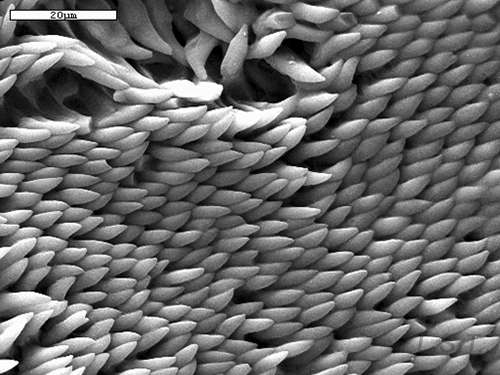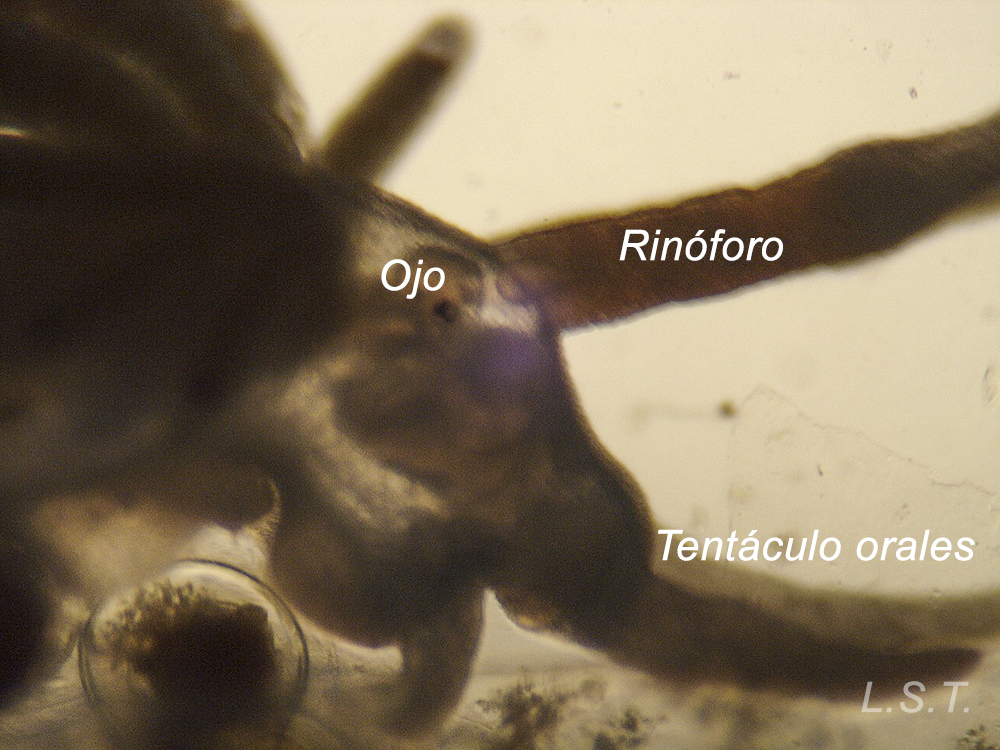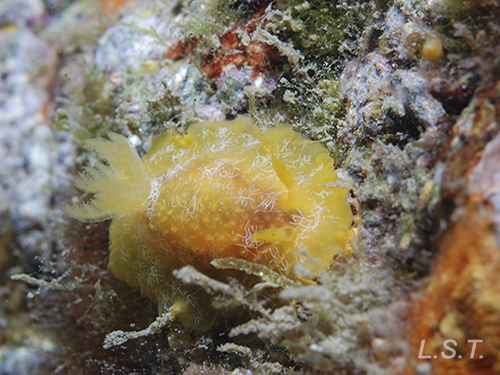Trapania hispalensis feeding on endoprocts.
The diet of the opisthobranchs is very varied; the species that belong to the orders of anaspideos and sacoglosos are herbivores and the rest, with some exceptions in cefalaspideos, are carnivores.
|
|
|
As we descend in the taxonomic classification, specialization increases, so that some species only feed on one type of prey. These are reflected in the radula which, as mollusks, is the structure they use to feed themselves. The sacoglosos have it adapted to break the strong walls of the vegetable cells and to be able to suck their content. Some sacoglossus species retain chloroplasts and these remain functional for a while. The name of sacoglosos comes from a sack where it gathers the old teeth of the radula.
|
|
|
The greatest variation in the shape of the radula occurs in the nudibranchs and within them in the doridáceos, due to the diversity of prey on which they feed. The species that feed on sponges have, in general, radules with numerous rows of curved teeth which are very similar to each other. Those that prey on bryozoans, ascidians or other prey, such as the European Tyrannodoris that preys on other doridáceos, have a lower number of rows and the shape of the teeth usually varies from the outside to the interior of the radula.

Juvenile of Tyrannodoris europea preying on Tambja ceutae and Tambja marbellensis
The species of the genus Trapania are specialized in the capture of endoprocts, small filtering animals that live fixed on sponges, ascidians, etc. Its radula has only two rows of teeth with denticles, which give them the appearance of rakes and with them, instead of collecting leaves, they remove the endoprocts from the substrate (sponges, ascidians, etc.)

Another structure that intervenes in the feeding, along with the radule, is the labial cuticle, a kind of lamina, normally, with numerous dentacillos denominated uncinos, which allows them to obtain a certain fixation to the substrate while they scrape its surface.

The radule of the Aeolideidae has few rows of teeth, with the center highly developed, and is surrounded by a strong jaw with which it retains its prey.
|
|
|
This group of nudibranchs normally feeds on cnidarians, with some exceptions such as: Godiva quadricolor, invasive species from South Africa, which feeds on other aeolids, polychaetes, etc.
Favorinus branchialis of nudibranch eggs

Some opisthobranchs, such as those belonging to the family Dendrodorididae, lack a radule and use instead a kind of tube with which they absorb their food.
MORE INFORMATION
PHOTOGRAPHS
|
|
|
|
|
|
|
|
|
 |
 |
VÍDEOS
18-05-2022 Tambja marbellensis feeding of Bryozoa Sessibugula barrosoi
BIBLIOGRAPHY
-Megina, C. 2000. Dieta y especialización trofica en Moluscos Nudibranquios. Tesis Doctoral. Universidad de Cádiz. Inédita.157 pp.
-Megina, C. Carballo, J.L., Cervera, J.L. y García-Gómez, J.C. 2002. The diet of Platydoris argo (Gastropoda: Nudibranchia) and the dietary secialization of sponge eating dorids. Journal of Molluscan Studies, 68: 173-179.
-Megina, C. y Cervera, J.L. 2003. Diet, prey selection and cannibalism in the hunter opisthobranch Roboastra europaea. Journal Molluscan Biology Association U.K., 83, 4059/1-8.
- Rudman, W.B. & Berquist, P.R.,2007. A review of feeding specificity in the sponge-feeding Chromodorididae (Nudibranchia: Mollusca). Molluscan Research 27(2): 60–88.
LUIS SÁNCHEZ TOCINO













